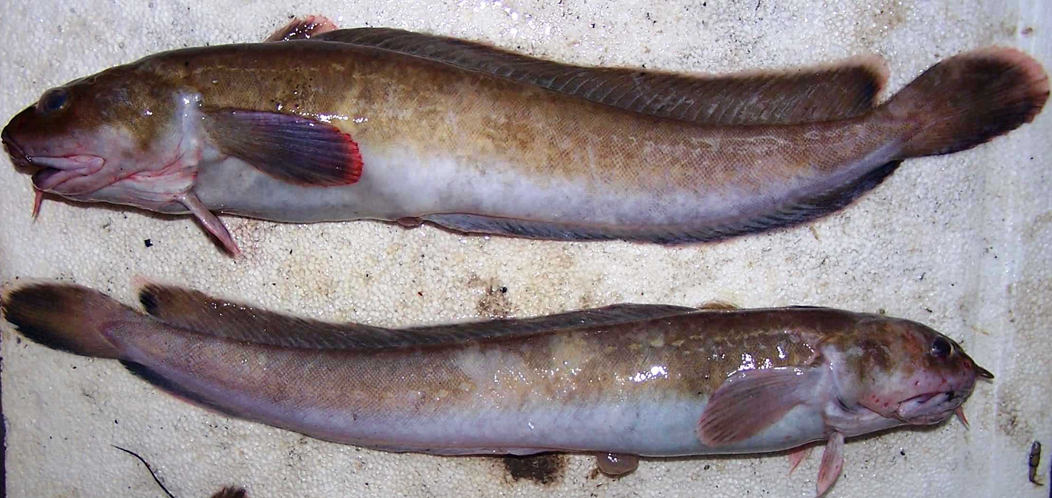Fourbeard rockling, Enchelyopus cimbrius (Linnaeus, 1766) as a by-catch
Fourbeard rockling, Enchelyopus cimbrius (Linnaeus, 1766) in accidental fish catches

In connection with many questions about the origin of dead fourbeard rockling stranded on Hel’s beach in January this year, NMFRI informs that:
- The Catch per Unit Effort (CPUE) for fourbeard rockling in the RV Baltica research catches, conducted in the first and fourth quarter of the year (BITS – Baltic International Trawl Surveys cruises realized within the Multiannual Programme for Collection of Fisheries Data) increased significantly in the years 2016-2017, which may show that more and more fish of this species inhabit the Polish Marine Areas. It should be noted, however, that at the same time the research effort also increased (number of hauls during cruises);
- An increase in the abundance of fourbeard rockling may be indirectly related to the decline in the biomass of eastern Baltic cod. Young cod and fourbeard rockling occupy the same ecological niche;
- Reports on the decline of fourbeard rockling resources, quoted by the Hel Marine Station of the Institute of Oceanography of the University of Gdańsk, concern the decline in the CPUE of this species in research catches in the Kattegat area (the strait between the Danish Jutland Peninsula and the Swedish Scandinavian Peninsula). Data from 1991-2010 for other regions (the Belt Sea, Arkona Basin) did not confirm this trend.
- As a result of increasing abundance of fourbeard rockling in the Polish Marine Areas, these fish may be more often by-caught in commercial catches, especially with respect to cod and flounder.
- Effective from January 1, 2015, the so-called ban on discards, i.e. the landing obligation, introduced by Regulation 1380/2013 of the European Parliament and of the Council on the Common Fisheries Policy, does not apply to fourbeard rockling. However, it concerns species exploited in fisheries, of which catches in the Baltic Sea are limited annually (catches regulated by quotas), i.e. herring, sprat, salmon, cod, and from 1 January 2017 – plaice.
- Since fourbeard rockling has so far been rarely recorded in the Polish statistics of commercial landings, fishers may have reasonable doubts as to how to deal with them. In Poland, fourbeard rockling is not subject to strict or partial protection pursuant to Art. 49 of the Act of April 16, 2004 on nature protection, because it is not an endangered species. In the case of accidental catching of a little-known fish, it is not a fisher’s offense to comply with the rules for protected species ordering its immediate release into the environment (§ 20 of the Regulation of the Minister of Maritime Economy and Inland Navigation of 16 September 2016 on size limits and closed seasons for marine organisms and detailed conditions for commercial fisheries).
- Chances of fourbeard rockling survival after retrieving nets on board and deploying them again into water are difficult to assess by fishers. There are no doubts only in case of dead fish or the ones with a swim bladder or digestive tract visible outside.
- Fourbeard rockling is not a commercial species, but can be processed for non-food purposes, similarly to fish below the protection size subject to the obligation to land (e.g. animal feed, fish meal). The Operational Program OP Fisheries and Sea 2014-2020 provides financial aid for investments in facilitating compliance with the obligation to land all catches within priority 1 – promoting environmentally sustainable, resource-efficient, innovative, competitive and knowledge-based fisheries. These investments will undoubtedly contribute to the minimization of discard of all aquatic organisms, with the exception of protected species that cannot be kept – even dead, sold, purchased, etc.
More information about fourbeard rockling and data recorded during research cruises performed by the NMFRI will be found in the next issue of Fisheries News.
Opublikowano 7 February 2018



